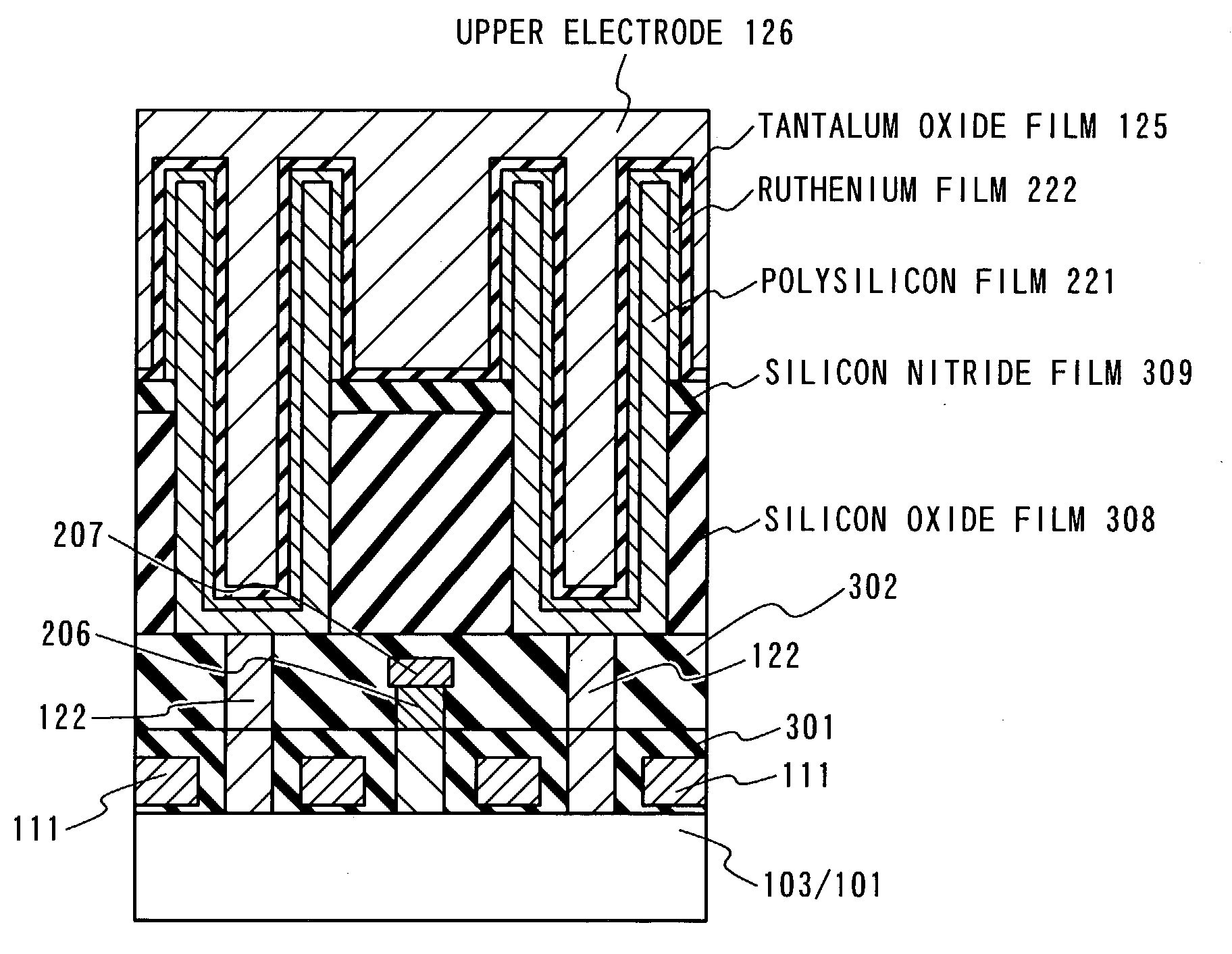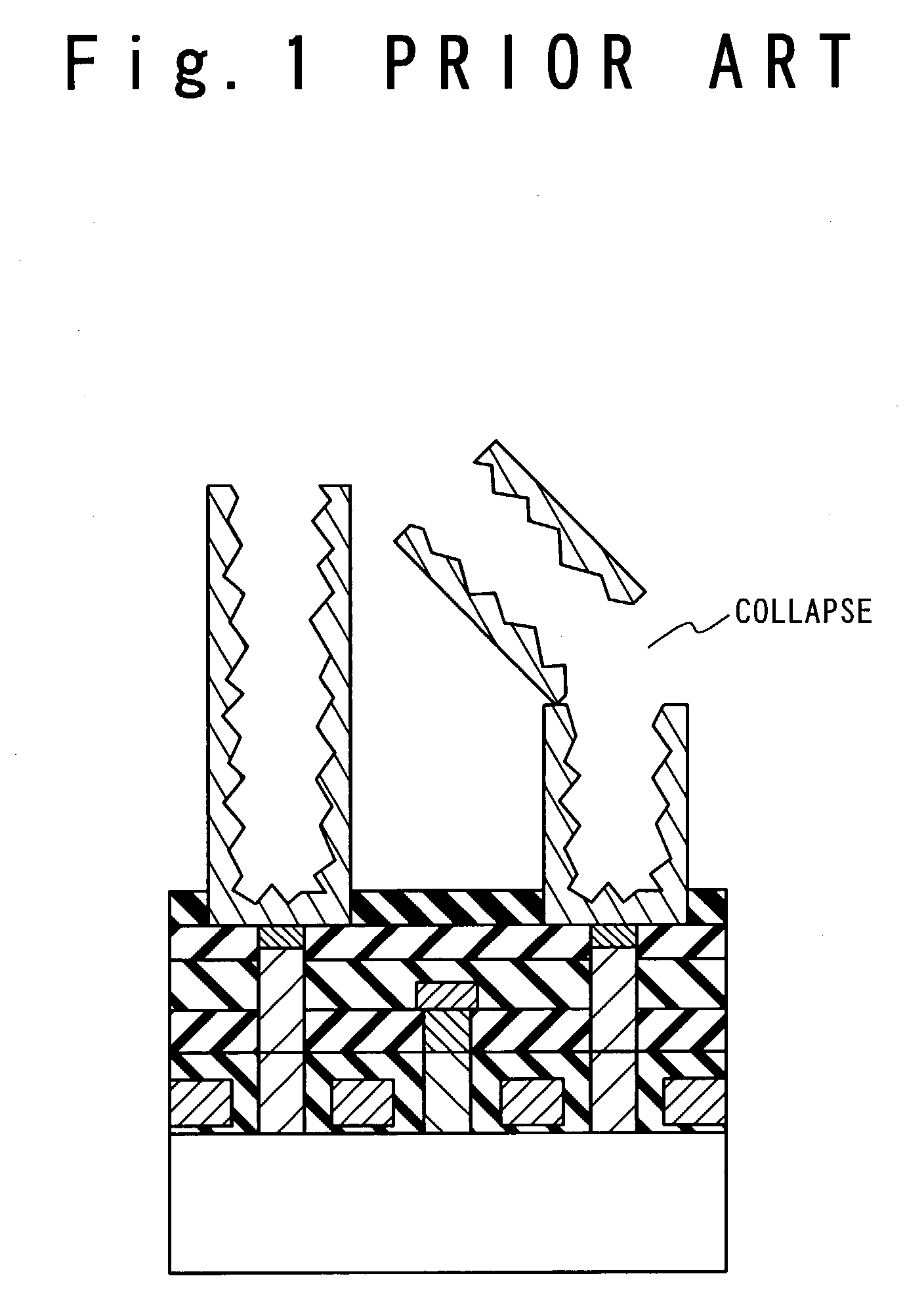Semiconductor integrated circuit device with capacitor of crown structure and method of manufacturing the same
- Summary
- Abstract
- Description
- Claims
- Application Information
AI Technical Summary
Benefits of technology
Problems solved by technology
Method used
Image
Examples
first embodiment
[0066]Next, the structure and manufacturing method of a capacitor in a DRAM as an example of the semiconductor integrated circuit device of the present invention will be described in detail with reference to FIGS. 4A to 4J. In the above description, the interlayer insulating film 123 is formed on the interlayer insulating film 121 and the dielectric film is formed on the interlayer insulating film 121 between the capacitors. In the following manufacturing method, however, an additional interlayer insulating film is formed between the interlayer insulating film 121 and the interlayer insulating film 123. In this case, the additional interlayer insulating film is removed from the area where the second plug contact portion is formed.
[0067]As shown in FIG. 4A, word lines 111 are formed on the silicon substrate 101 or the P-well 103 via an insulating film. These word lines correspond to the gates of the transistors in FIG. 3. After a first interlayer insulating film 203 is formed to cove...
second embodiment
[0088]The semiconductor device according to the second embodiment of the present invention will be described referring to FIGS. 8A and 8B. In the first embodiment, the example is described in which the polysilicon film or / and the metal silicide film are formed below the ruthenium film. In the second embodiment, however, an example will be described in which a metal film or metal compound is used instead of the polysilicon film.
[0089]In case where a ruthenium film is formed on a metal film or a metal compound film as a base film and the selective anisotropic dry etching is applied, the ruthenium film on the top of crown structure is removed while the ruthenium film around the crown structures is removed. As a result, the base film is exposed and contacts directly with the dielectric layer of tantalum oxide. Such a situation does not matter when the base film material is polysilicon or silicide, while increase in leakage current is inevitable when the base film material is a metal lay...
third embodiment
[0094]Next, a semiconductor integrated circuit device according to the third embodiment of the present invention will be described. In the third embodiment, a ruthenium film is grown selectively by the CVD method. Thus, a ruthenium film is formed on the surface of the polysilicon film.
[0095]First, FIG. 10 shows the dependency of the growth of a ruthenium film by the CVD on the base film material. The vaporized gas of Ru(EtCp)2 diluted by THF was used as a material gas, as a conventional example. The flow rate was 5 sccm. Simultaneously, oxygen with the flow rate of 50 sccm was supplied as a reaction gas. The temperature was 295° C. and the pressure was 60 Pa. Samples were prepared such as a silicon substrate, a silicon oxide film, a titanium nitride film, a titanium silicide, a tantalum oxide, a tantalum nitride, and a ruthenium film formed by a sputtering method as the base film materials. The deposition of a ruthenium film is tried on each sample under the same condition. The depe...
PUM
 Login to View More
Login to View More Abstract
Description
Claims
Application Information
 Login to View More
Login to View More - R&D
- Intellectual Property
- Life Sciences
- Materials
- Tech Scout
- Unparalleled Data Quality
- Higher Quality Content
- 60% Fewer Hallucinations
Browse by: Latest US Patents, China's latest patents, Technical Efficacy Thesaurus, Application Domain, Technology Topic, Popular Technical Reports.
© 2025 PatSnap. All rights reserved.Legal|Privacy policy|Modern Slavery Act Transparency Statement|Sitemap|About US| Contact US: help@patsnap.com



